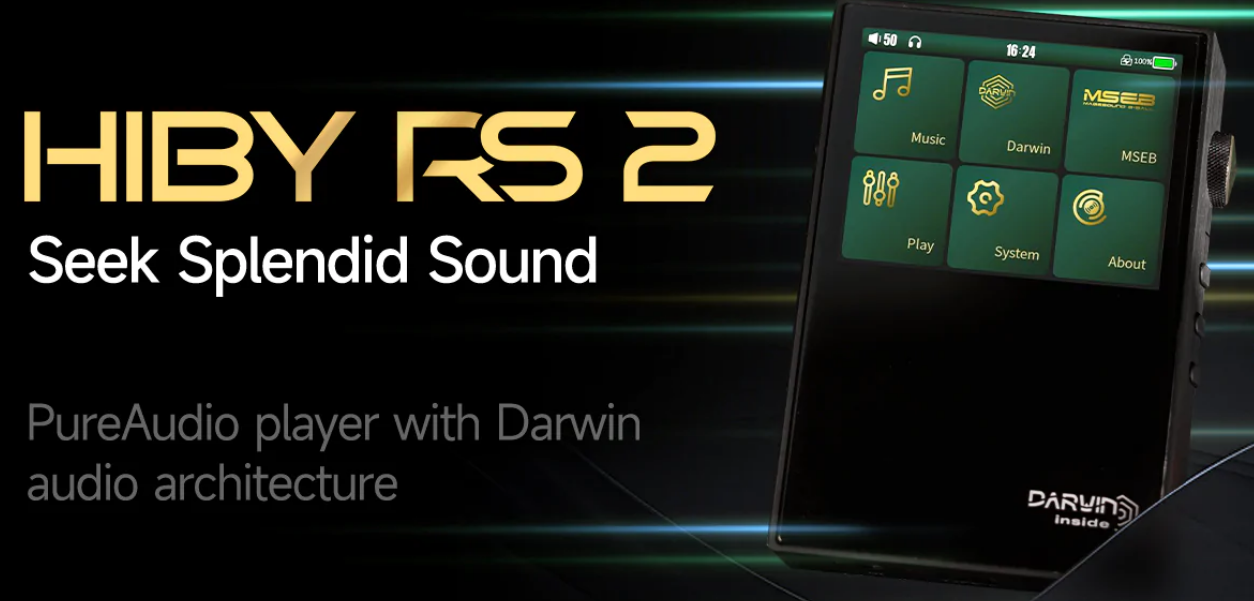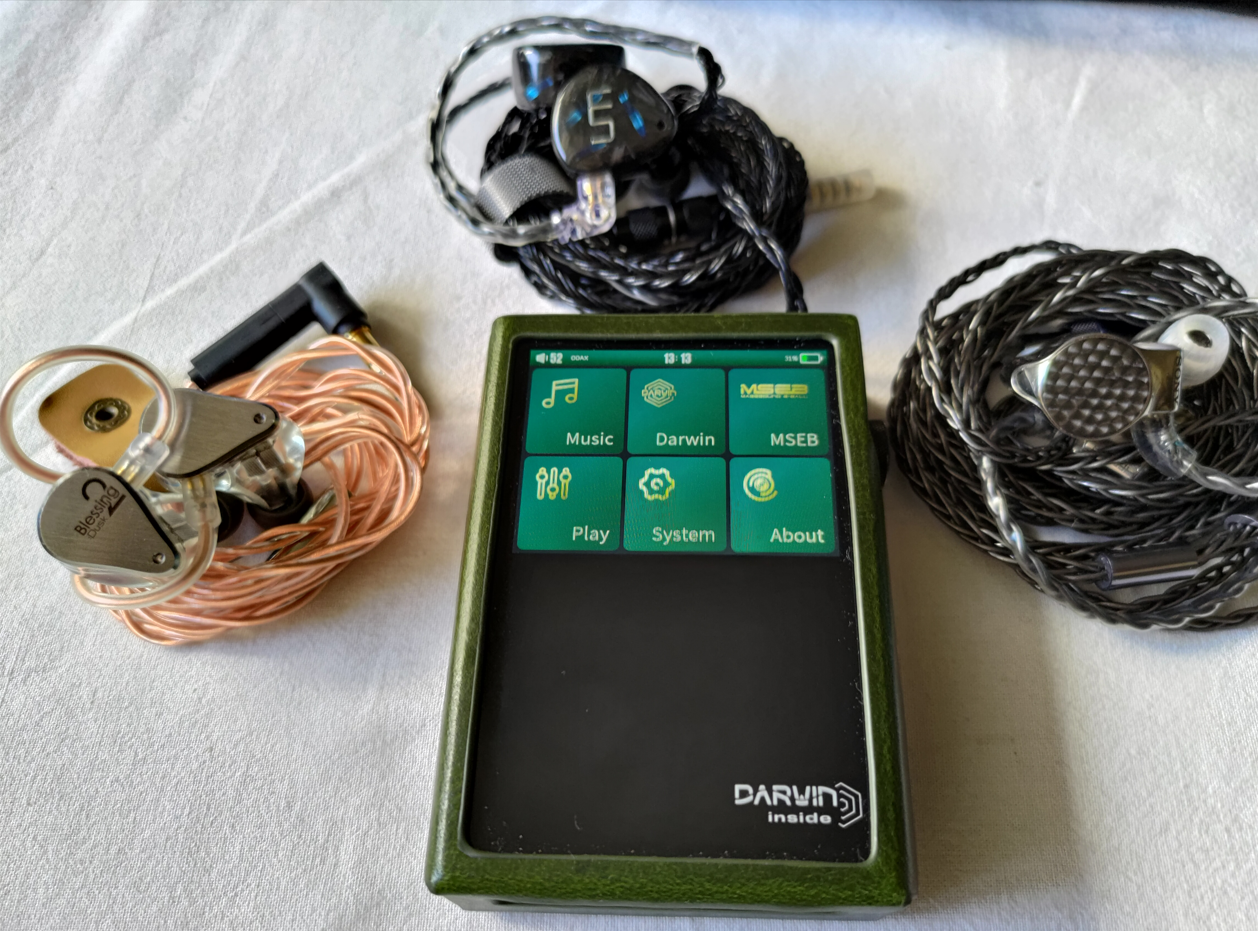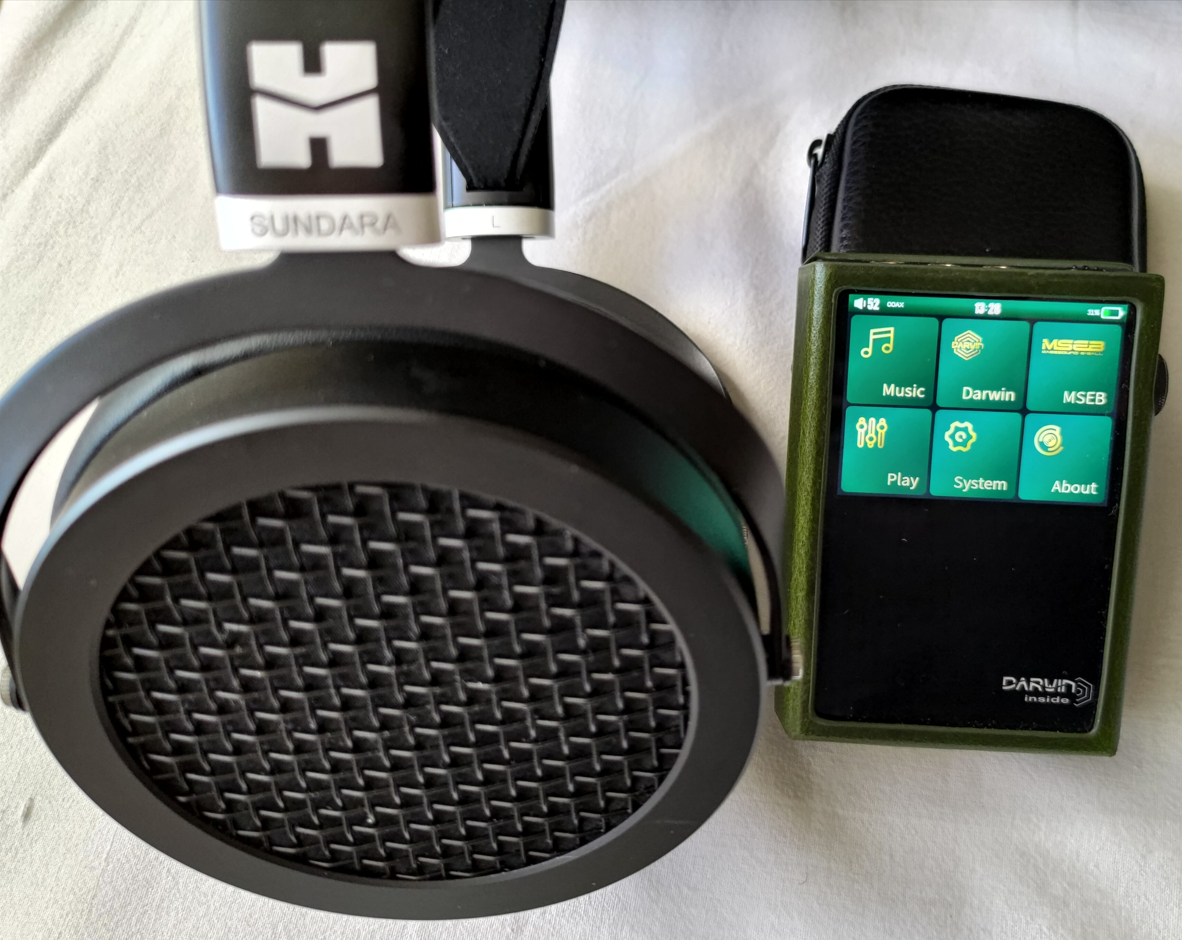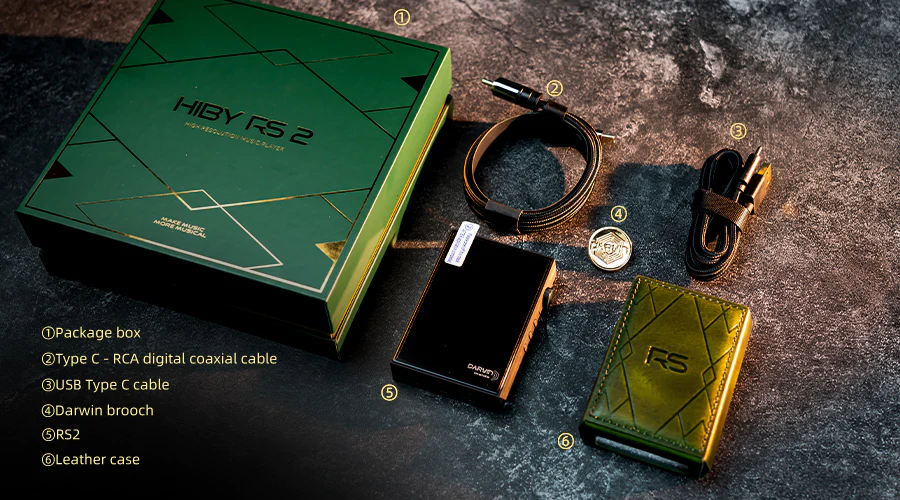General Information
PROS
+ Full R2R presentation
+ Natural timbre and zero digital glare
+ Solid detail retrieval
+ Wide soundstage and spectacular depth
+ Very good battery live, no drain function
+ Premium build quality
+ Comes with a carrying case and premium rare cables USB cable
CONS
- Many filters but not clear which is what (no names)
- No BT or Wi-Fi connection
- A short Type-C to Type-C cable missing
- Menu is simple but some illogical in structure
Intro
Last year, HiBy released the RS6 digital audio player – a solid, full of functionalities, R2R DAP (I still haven’t laid my hands on it because of its price). The RS6 started the premium R2R-based Darwin Architecture for portable digital audio players for the brand.
And recently Hiby launched the RS2 which got my attention immediately since it had an affordable price level while bringing the goodness of R2R DACs with modern functions like adjustable FIR filter, Harmonic controller, NOS/OS, etc. It is a pure audio player with the HiBy OS PureAudio version. I bought it immediately when it appeared in MusicTeck website (should out for them – wonderful service!).

The player comes loaded with a specially tailored OS - a simplified user interface and menu structure (no Android).It is my first real DAP (I have the Fiio Q5S but it is not a real DAP for me).
So, here I present to you my initial 4-day impressions. Please, have in mind that this is a bit unorthodox review – I am not the polished reviewer type, engaged dedicatedly to providing reviews, sourced by companies and the community with precious and new gear. I review and comment on what I have, what fits my collection, what I find unorthodox like a product, the gear that impresses me a lot (or disappoints me) and is still uncovered, according to me.
SOME FACTS:
The Hiby RS2 is not a big device – the photos in the ads created wrong expectations; it is small like a pack of cigarettes – a bit wider and thinner, but shorter. But it feels heavy, solid piece of gear with a premium design and materials. I wish it was not that shorter for my hands and the only critics I have on the accessories is that USB Type-C cable is provided but a short Type-C to Type-C is not (my use case for the MQA is sourcing from phone).
The most other attractive facts for me are:
Yes, I want to stress on the expression ‘listening impressions”. Some time ago I was fascinated by the Cayin RU6 – it changed a lot for me making me buy the Ares II and later upgrade to IFI Pro iDSD looking for the naturalism and musicality plus a solid technicalities like sound stage width and depth, layering, … So, what I will speak about are not the mere specs neither if this is the most hi-tech device you can get. I will focus on the R2R performance and what does it give me.
The Hiby RS2 has close to linear frequency response with a bit of warmth and mid-centric focus, very good technicalities and wonderful transparency. The presentation is always very smooth, coherent, and balanced while being also immersive and musical. There is zero digital glare, timbre is natural and all instruments, female/male voice sound naturalistic and capturing. The sound is textured, slightly alluring, everything is well controlled without too much intensity and artificial energetics.
I think the upper part of the frequency spectrum is very slightly subdued – do not get me wrong the information is there, everything is clearly catchable, just it is not presented with many sparkles and flashes.
The bass is well present, tight, and clear. It is never too much, neither not enough. I am very impressed with bass since it is full of texture but fast. And it made we go back to some gear that was put aside - later you will understand more.
The mids and volcals – depends on how you like it! What do I mean!? At the Cayin RU6 and the Ares II I do prefer on OS mode. With the RS2 I prefer the NOS – the OS makes the reproduction a bit much mid-centric to my liking, the vocals come closer and some-how that shrinks a bit the sound stage; while the NOS mode sounds very organic, natural, well layered, a bit more expansive, and I cannot say I was missing smoothness.
The lack of lushness and sparkles in the presentation is compensated by the excellent imaging, the amazing space between instruments, the very good layering and depth of the stage. and the precision of the positioning. I cannot say that the fidelity is just 100% (last two months I got spoiled by a set-up of IFI Pro iDSD –> Burson Soloist 3 XP / Stax SRM-007t Mjolnir) but the great combination of dynamics with natural timber plus naturalistic presentation with great coherence plus the convincing soundstage integrity are marvelous. Just imagine you listen to WASP’s ‘Keep Holding On’ and ‘The Idol’ at a concert – yep, the RS2 did it close for me; a smidge below the Ares II (except for the sound stage width). To conclude the RS2 has natural, clear, well-articulated, balanced, rich but not analytical presentation. It is quite above the RU6 nearly trying to reach for the Ares II.
MENU, FUNCTIONALITIES, BUTTONS
Yep, the menu is fairly simple but there are some illogical decision about its structure. Here are the most things which I refuse to accept: 1/ Why the Gain is buried in the Play menu so down, next to the Crossfade?! and can be accessed only from the Home screen; 2/ Why the NOS is in the Darwin menu!? Only Darwin has NOS/OS!? and can be accessed only from Home screen;

There is no button to wake up the screen when it sleeps – you must tap twice on the screen!!! and most often need a second hand. And then the screen you get is a clock but not the band/song you are playing!!! so you must slide that screen right. Reaching the Home screen when playing music needs several slides right since you’re a going back through the folders structure, and the NOS/OS and Gain and Crossfade you can reach only from Home screen going back and back. Only the Equalizer and the Equalizer styles like Pop/ROCK/Jazz… is easy to access. Screen is too short for the many functionalities in each menu.
The volume button scale can be fine tuned from the menu and is very precise and with nice tactility when rotating. The other three buttons for song forwards/backwards and pause/play are easy to find and operate.
Otherwise, many of the functionalities are really useful – I find especially well implemented the Crossfade, it is just enough. I like very much the Darwin’s Harmonic controller – I feel like it gives me the chance to choose between bigger space b/n instruments plus bigger soundstage vs more musical reverberation, sometimes resembling tubes type, and balance between these. Also the MSEB menu with Overall Temperature, Bass extension/texture, Note thickness, Vocals forwardness, Sibilance, … worked very well for me in some cases, but I do not believe I will play with it since it is a bit tricky to fine tune – the sensitivity is too big.
PAIRING with IEMs and HEADPHONEs
I will not quote the power output specs and speculate on them – empiric impressions and experience are more valid for me. Noise from the 3,5 mm or 4,4 mm is not existing for me – zero!
I dare to make the following statement – nearly every iem from my big collection does well with the Hiby RS2. Even more, in most of the case, I felt like the RS2 knows what needs to improve in the iem. Examples:



Conclusion
If you don't mind something bigger than a dongle but still compact to carry in a pocket (heavy and bulky) and would like to have the R2R presentation always with you, than RS2 is a perfect gear for that. It deserves any penny. I am already convinced I will not regret my purchase and that the Fiio Q5s will start getting dusty. Meanwhile I will never miss my Ares II fully when on the go.
And most important I started rediscovering my iems and some headphones – the RS2 is reviving some of them to me which makes me very happy. Even more, many times I found myself feeling that I am connected to a desktop set-up.
Big Update (August 29, 2024)
For more than an year I was also using a Chord Mojo 2. I was mainly using these like DAPs for IEMs and enjoyed them both. They are quite a complementary pair of DAPs and I cannot say which one is better. Wanna have fast, clear, vocal centric replay with bigger than average soundstage -> go for Mojo 2; Wanna have very extended bass, highly natural timber, good smoothness w/o losing detail -> go for Hiby RS2.
But for the last year I was went back to Stereo speakers systems and got a fairly good one: Eversolo A6 streamer -> TT2 -> Echo MkII -> LA90 discreet or TT2 -> SMSL A1 and speakers ELAC UBR62. And from time to time I was changing the TT2 to iFi iDSD Pro but started craving for some R2R flavor. And here comes the Hiby RS2 - I sed its LO to the LA90 / SMSL A1 and I was amazed. I got fully R2R presentation that had everything you expect from R2R and a soundstage size slightly below that of the iFi iDSD Pro but very very big for a small DAC like the Hiby RS2. And I listened listened listened and love it.
Later I decided to compare it to the Mojo 2 and very fastly I understood there is no competition here - the Hiby RS2 sounds better to me in this system in every aspect. It is only if you are hard vocal centric to prefer the Mojo 2.
So great job from Hiby with the RS2!

+ Full R2R presentation
+ Natural timbre and zero digital glare
+ Solid detail retrieval
+ Wide soundstage and spectacular depth
+ Very good battery live, no drain function
+ Premium build quality
+ Comes with a carrying case and premium rare cables USB cable
CONS
- Many filters but not clear which is what (no names)
- No BT or Wi-Fi connection
- A short Type-C to Type-C cable missing
- Menu is simple but some illogical in structure
Intro
Last year, HiBy released the RS6 digital audio player – a solid, full of functionalities, R2R DAP (I still haven’t laid my hands on it because of its price). The RS6 started the premium R2R-based Darwin Architecture for portable digital audio players for the brand.
And recently Hiby launched the RS2 which got my attention immediately since it had an affordable price level while bringing the goodness of R2R DACs with modern functions like adjustable FIR filter, Harmonic controller, NOS/OS, etc. It is a pure audio player with the HiBy OS PureAudio version. I bought it immediately when it appeared in MusicTeck website (should out for them – wonderful service!).

The player comes loaded with a specially tailored OS - a simplified user interface and menu structure (no Android).It is my first real DAP (I have the Fiio Q5S but it is not a real DAP for me).
So, here I present to you my initial 4-day impressions. Please, have in mind that this is a bit unorthodox review – I am not the polished reviewer type, engaged dedicatedly to providing reviews, sourced by companies and the community with precious and new gear. I review and comment on what I have, what fits my collection, what I find unorthodox like a product, the gear that impresses me a lot (or disappoints me) and is still uncovered, according to me.
SOME FACTS:
The Hiby RS2 is not a big device – the photos in the ads created wrong expectations; it is small like a pack of cigarettes – a bit wider and thinner, but shorter. But it feels heavy, solid piece of gear with a premium design and materials. I wish it was not that shorter for my hands and the only critics I have on the accessories is that USB Type-C cable is provided but a short Type-C to Type-C is not (my use case for the MQA is sourcing from phone).
The most other attractive facts for me are:
- RS2 features OS (OverSampling) mode and NOS (Non-OverSampling)
- The Darwin architecture here houses a 256-tap adjustable FIR filter. It is capable of up to 16x oversampling with a variety of AA filters like Phase linearity, High-Fidelity, etc.
- HiBy has featured an FPGA clock system with precise dual crystal oscillators.
- The player comes with a high-current mode amplification circuit with an OPA1652 and an LPF circuit with dual OPA1612 chips.
- RS2 comes with a single-ended 3.5 mm and balanced 4.4 mm headphone output ports.
- HiBy RS2 supports high-resolution PCM, and DSD signals. It supports PCM signals up to 32-Bit/384kHz and native DSD256 decoding. RS2 also supports 8x MQA
- RS2 with dual memory card slots each supporting up to 2 TB of microSD cards.
- HiBy RS2 has got a large 3500mAh battery (close to 10h at higher gain at 30%. Delivered during my 4-day ‘test’)
- For all the rest – check the official website: https://store.hiby.com/products/hiby-rs2
Yes, I want to stress on the expression ‘listening impressions”. Some time ago I was fascinated by the Cayin RU6 – it changed a lot for me making me buy the Ares II and later upgrade to IFI Pro iDSD looking for the naturalism and musicality plus a solid technicalities like sound stage width and depth, layering, … So, what I will speak about are not the mere specs neither if this is the most hi-tech device you can get. I will focus on the R2R performance and what does it give me.
The Hiby RS2 has close to linear frequency response with a bit of warmth and mid-centric focus, very good technicalities and wonderful transparency. The presentation is always very smooth, coherent, and balanced while being also immersive and musical. There is zero digital glare, timbre is natural and all instruments, female/male voice sound naturalistic and capturing. The sound is textured, slightly alluring, everything is well controlled without too much intensity and artificial energetics.
I think the upper part of the frequency spectrum is very slightly subdued – do not get me wrong the information is there, everything is clearly catchable, just it is not presented with many sparkles and flashes.
The bass is well present, tight, and clear. It is never too much, neither not enough. I am very impressed with bass since it is full of texture but fast. And it made we go back to some gear that was put aside - later you will understand more.
The mids and volcals – depends on how you like it! What do I mean!? At the Cayin RU6 and the Ares II I do prefer on OS mode. With the RS2 I prefer the NOS – the OS makes the reproduction a bit much mid-centric to my liking, the vocals come closer and some-how that shrinks a bit the sound stage; while the NOS mode sounds very organic, natural, well layered, a bit more expansive, and I cannot say I was missing smoothness.
The lack of lushness and sparkles in the presentation is compensated by the excellent imaging, the amazing space between instruments, the very good layering and depth of the stage. and the precision of the positioning. I cannot say that the fidelity is just 100% (last two months I got spoiled by a set-up of IFI Pro iDSD –> Burson Soloist 3 XP / Stax SRM-007t Mjolnir) but the great combination of dynamics with natural timber plus naturalistic presentation with great coherence plus the convincing soundstage integrity are marvelous. Just imagine you listen to WASP’s ‘Keep Holding On’ and ‘The Idol’ at a concert – yep, the RS2 did it close for me; a smidge below the Ares II (except for the sound stage width). To conclude the RS2 has natural, clear, well-articulated, balanced, rich but not analytical presentation. It is quite above the RU6 nearly trying to reach for the Ares II.
MENU, FUNCTIONALITIES, BUTTONS
Yep, the menu is fairly simple but there are some illogical decision about its structure. Here are the most things which I refuse to accept: 1/ Why the Gain is buried in the Play menu so down, next to the Crossfade?! and can be accessed only from the Home screen; 2/ Why the NOS is in the Darwin menu!? Only Darwin has NOS/OS!? and can be accessed only from Home screen;

There is no button to wake up the screen when it sleeps – you must tap twice on the screen!!! and most often need a second hand. And then the screen you get is a clock but not the band/song you are playing!!! so you must slide that screen right. Reaching the Home screen when playing music needs several slides right since you’re a going back through the folders structure, and the NOS/OS and Gain and Crossfade you can reach only from Home screen going back and back. Only the Equalizer and the Equalizer styles like Pop/ROCK/Jazz… is easy to access. Screen is too short for the many functionalities in each menu.
The volume button scale can be fine tuned from the menu and is very precise and with nice tactility when rotating. The other three buttons for song forwards/backwards and pause/play are easy to find and operate.
Otherwise, many of the functionalities are really useful – I find especially well implemented the Crossfade, it is just enough. I like very much the Darwin’s Harmonic controller – I feel like it gives me the chance to choose between bigger space b/n instruments plus bigger soundstage vs more musical reverberation, sometimes resembling tubes type, and balance between these. Also the MSEB menu with Overall Temperature, Bass extension/texture, Note thickness, Vocals forwardness, Sibilance, … worked very well for me in some cases, but I do not believe I will play with it since it is a bit tricky to fine tune – the sensitivity is too big.
PAIRING with IEMs and HEADPHONEs
I will not quote the power output specs and speculate on them – empiric impressions and experience are more valid for me. Noise from the 3,5 mm or 4,4 mm is not existing for me – zero!
I dare to make the following statement – nearly every iem from my big collection does well with the Hiby RS2. Even more, in most of the case, I felt like the RS2 knows what needs to improve in the iem. Examples:
- 7hz Timeless runs with zero sibilance and an gets absolute bang for its money;
- the JVC HA-FDX1 is not at all lean sounding in the bass and gets good bass hump;
- the Blessing2 Dusk gets very musical and presents very big sound stage - I rediscovered its high qualities and started loving it a lot;
- the ThieAudio Legacy 3 is absolute bliss of musicality; btw it is a very sensitive iem which is a benchmark for me for the noise floor – no issue with the RS2;
- Sony IER-Z1R – oooOMG, the RS2 brings the vocals a bit closer and the presentation is with abnormally wide sound stage for an iem;
- The UM Mest v1 – this pairing is end-game for me, I am not buy any other iem before I test it personally (do not make me bet on that, pleas




Conclusion
If you don't mind something bigger than a dongle but still compact to carry in a pocket (heavy and bulky) and would like to have the R2R presentation always with you, than RS2 is a perfect gear for that. It deserves any penny. I am already convinced I will not regret my purchase and that the Fiio Q5s will start getting dusty. Meanwhile I will never miss my Ares II fully when on the go.
And most important I started rediscovering my iems and some headphones – the RS2 is reviving some of them to me which makes me very happy. Even more, many times I found myself feeling that I am connected to a desktop set-up.
Big Update (August 29, 2024)
For more than an year I was also using a Chord Mojo 2. I was mainly using these like DAPs for IEMs and enjoyed them both. They are quite a complementary pair of DAPs and I cannot say which one is better. Wanna have fast, clear, vocal centric replay with bigger than average soundstage -> go for Mojo 2; Wanna have very extended bass, highly natural timber, good smoothness w/o losing detail -> go for Hiby RS2.
But for the last year I was went back to Stereo speakers systems and got a fairly good one: Eversolo A6 streamer -> TT2 -> Echo MkII -> LA90 discreet or TT2 -> SMSL A1 and speakers ELAC UBR62. And from time to time I was changing the TT2 to iFi iDSD Pro but started craving for some R2R flavor. And here comes the Hiby RS2 - I sed its LO to the LA90 / SMSL A1 and I was amazed. I got fully R2R presentation that had everything you expect from R2R and a soundstage size slightly below that of the iFi iDSD Pro but very very big for a small DAC like the Hiby RS2. And I listened listened listened and love it.
Later I decided to compare it to the Mojo 2 and very fastly I understood there is no competition here - the Hiby RS2 sounds better to me in this system in every aspect. It is only if you are hard vocal centric to prefer the Mojo 2.
So great job from Hiby with the RS2!


























